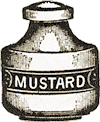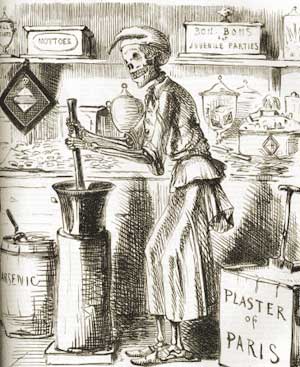The bane of commerce and health
There is much written these days about chemical, hormone and steroid food additives as well as actually genetic engineering which is changing the properties of the food that we eat at the most basic levels. And while we sometimes think that the food we eat is killing us, there is no doubt that it was doing exactly that back in the 19th century.

It wasn't until 1875 that laws regulating food adulteration first came into existence. Prior to that it was "anything goes" and "anything" is what you commonly found in your food. The problem was, most of the food additives of the time were actually poisonous.
Bakers added alum and chalk to their bread to make it whiter while cooks mixed plaster of paris, clay and sawdust into their mashed potatoes. There was even a time when the very potent rat poison strychnine was added to beer to improve the flavour by making it more bitter!
People grew accustomed to these additives and actually began to accept them and the "improved taste" that went along with them. Even tea was chemically altered so that used tea leaves could be "rejuvenated" by boiling them in a mixture of ferrous sulphate and sheep manure and then artificially coloring the leaves with chemicals including ferric ferrocyanide, copper acetate, or tannin.

The Great Lozenge-Maker (Punch 1858)
It's no wonder that people didn't have cholesterol problems in spite of their high fat meals, the chemicals in their body were probably destroying everything they contacted from the inside out!
Coffee drinkers didn't fare any better as used beans were mixed with roasted beans of a non-coffee variety, sand and gravel, chicory, carrots and burnt sugar and then sold as the real thing!
Common adulterations in the 19th century.
- Allspice
- with mustard husks;
- Anchovies
- with Armenian bole, Venetian red, red ochre;
- Arrowroot
- with cheaper starches—sago, tapioca, potato;
- Bread
- with potatoes, alum, and inferior and deseased flour;
- Butter
- with colouring matter, water, salt, lard, tallow, and other fats;
- Cayenne
- with ground rice, vermilion , Venetian red, and tumeric;
- Cheese
- with colouring matter;
- Cocoa and Chocolate
- with arrowroot and other starchy matters;
Many of the foods and beverages of the time were high in lead, copper and mercury. Even then mercury was a problem but it was because it was being added to foods on purpose! In fact, much of the candy sold to children was colored with tinctures of lead, copper and mercury. Not only could candy rot your teeth, but it could rot your stomach, heart and lungs as well.

As the scientific and medical community started waking up to the dangers of food adulteration, laws were passed and companies were put on notice. Some scientists quickly made enemies of the food manufacturers, who were politically connected, and their lives became miserable as a result of trying to bring about change.
Chemical additives weren't the only problems in the food of the 19th century. Weevils were common in grains and flour and sugar mites infested nearly every package of brown sugar sold. In spite of all the findings, the first Food Adulteration Protection Act was not passed until 1860; but it had few teeth and did little to change what was going on in the industry.
1872 saw a revised Act passed, 1875 saw another, but it wasn't until the Food Adulteration Act of 1899 passed that use of poisonous food additives started winding down in ernest. While there was no stopping the household cook from thickening the gravy with a pinch of plaster, the major food manufacturers were no longer killing their customers systematically and on purpose.
Sources L. Jackson, The Victorian Dictionary, 29 Sept 2005, <http://www.victorianlondon.org/>